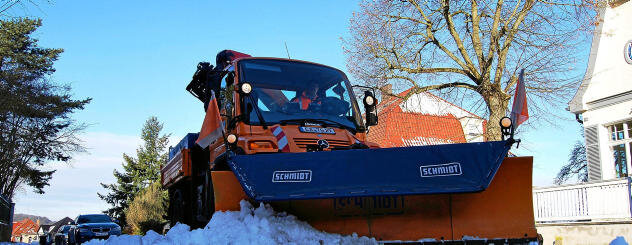It is the winter maintenance routine every evening. The winter service supervisor on duty looks at the screen on which the forecast of the German Weather Service for the next few hours flickers. This prediction is decisive for whether the 30 employees of the municipal winter service have to start their work the next morning at 4 a.m., whether they are called to readiness or whether they can sleep a little longer and then be at the post at 7.15 a.m. at the normal time have to.
"The forecast is much better than the weather apps on the cell phone, you can rely on it, but it always remains a bit of an oracle," knows Holger Rudolph. The 46-year-old Eisenacher has been with the municipal building yard for 26 years and has a long title, namely acting deputy head of the building yard and is one of those three winter service managers.
Winter service is of course a special challenge for each individual, because night shifts, as in any other profession affected by it, turn the daily routine completely upside down. It just starts at 4 a.m. and starts at 7.15 a.m. with the normal shift until 1.15 p.m. "When I get home, I usually first lie down a little and sleep". In the evening it is “actually after the sandman in bed”, laughs Rudolph. But if you still want something from your family, you can stay up until 9 p.m. But then it's over, after all, at three o'clock the night is over. Winter service families do not have a common winter vacation.
The second shift starts at 4.15 p.m. and continues until 10 p.m. on weekdays and until 8 p.m. on weekends.
In Eisenach there are two winter service departments, one of which is responsible for the streets, the other for the sidewalks and staircases, which is responsible for the city, also because, like every other house owner, they are obliged to clear the paths along their own properties. There are five road tours on which the city clears according to a set tour plan. Federal and main roads in the urban area have priority, there are also important steep stretches and roads on which the buses run. The three vehicles from the building yard and two vehicles from external companies are available for this. The winter service is required by law from 6 a.m. to 10 p.m.
A tour takes about three hours
And yet the Eisenachers start at four o'clock so that the main roads are cleared and gritted before the start of rush-hour traffic in the morning hours. The tours are designed to last around three to three and a half hours in normal winter conditions.
"It doesn't happen in every municipality that the main roads are completely free of ice and snow for almost the whole winter," reports Thomas Filler, department manager for the building yard and winter service manager. That is a somewhat luxurious state, but the residents would have quickly got used to it. In other municipalities it is quite common to drive on white roads when there is really snowfall, "it's winter".
Rudolph doesn't want to complain about his job. Even if he doesn't sit at the steering wheel of Unimog and Co. that often, he knows that for many colleagues it is also a nice thing to move the powerful technology and powerful machines. “It won't get boring and every day brings different challenges”.
One of these special challenges is the Südstadt tour: steep, smooth, winding and narrow. The sliding plate at the front of the truck, which weighs around a ton, is 3.20 meters wide, but since it is tilted at an angle to push the snow to the side, it needs space 2.75 meters in width. And this place doesn't always exist, especially in the Südviertel. “If you park on both sides, it is sometimes an inch,” says Rudolph. A lot of experience and a good eye pay off.
It becomes even more difficult when the property owners pile up the snow from the sidewalk on the street at the edge. Then the parked cars will still move a little further into the street itself. Folded exterior mirrors would help a little. Rudolph knows, of course, that the residents get annoyed when they have just cleared the sidewalk, and then the winter service pushes the white splendor back onto the sidewalk. "I would be annoyed, but sometimes there is just so little space that there is no other way." And the clearing vehicles are already driving extra slowly so that no more snow than necessary flies back onto the sidewalks in the worst-case scenario.
20 km / h is roughly the normal speed. Whereby this speed would rarely be reached on the complicated tours such as Südviertel, Hofferbertaue or Ramsberg. “We actually experience the streets as wintry, nobody has cleared the road before us,” says Rudolph.
Salt is only used on the sidewalks in Eisenach in an emergency, usually granules are scattered. A litter filling is around 350 to 400 kilos of granulate.
